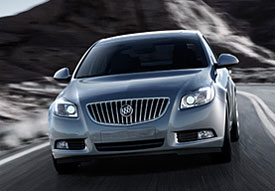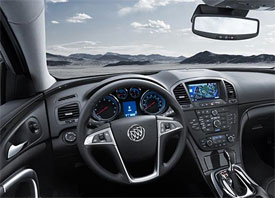2011 Buick Regal
While most buyers think of Buick as a posh, premium brand, their performance car history actually dates back to the legendary straight-8s of the 1930s. In more recent decades, the Regal nameplate carried the best of Buick’s performance intensions. So it makes sense that when Buick planned an all-new, mid-size sports sedan that the Regal name would once again appear. But this Regal is not like any Buick we’ve driven before.
After a six-year absence, the Buick Regal returns for 2011 as an all-new Euro-bred, front-drive sports sedan. Developed at Germany’s famed Nurburgring, the new Regal is a near doppelganger to the Opel Insignia – Europe’s 2009 Car of the Year, and the most promising entry from GM’s tri-shield division since the Grand Nationals of the 1980’s. To that end, the Regal will compete with premium-level sports sedan like the Audi A4, Acura TSX, Volkswagen CC, and Volvo’s new S60.
Initially imported in premium CXL trim only, the Regal touts the same sleek and upscale design language, but adds a healthy dose of frontal aggression from the LaCrosse and Enclave - an oversized Buick waterfall grille, flanked by prominent, swept-back, non-HID headlamps.
 The Regal’s sculpted coupe-like profile features a fast, flowing roofline, sharp body creases, and flared fenders, exuding a performance-oriented spirit. The tapered rear wears an abbreviated deck and bold tail lamps, both hallmarks of the contemporary sports sedan. Standard alloy wheels are 18-inch, with 19s optional.
The Regal’s sculpted coupe-like profile features a fast, flowing roofline, sharp body creases, and flared fenders, exuding a performance-oriented spirit. The tapered rear wears an abbreviated deck and bold tail lamps, both hallmarks of the contemporary sports sedan. Standard alloy wheels are 18-inch, with 19s optional.
Power will be a surprise to some, four cylinder direct-injected powertrains only from GM’s Ecotec family. The standard 2.4-liter, shared with the Lacrosse and Chevy Equinox, delivers 182 horsepower and 172 pound-feet of torque.
Optional is a 2.0-liter twin-scroll turbo with 220 horsepower and 258 pound-feet of torque. An even higher-performance turbo GS arrives next year. The 2.4 is mated to a self-shift six-speed automatic, while the 2.0 turbo offers a proper six-speed manual as standard and automatic as option. Unfortunately, for our test runs only a 2.4 automatic was available.
And while it felt pretty peppy off the line, it was only adequate overall; taking a longish 9.4 seconds to get to 60, and 17 seconds to complete the quarter mile at 84 miles per hour. We’d definitely opt for the 2.0 turbo. But, it is taking corners where this Regal shines brightest. The Epsilon II chassis, with its strut-type front, and four-link rear suspension, both with a hollow stabilizer bar, delivered an impressive level of agility and nimbleness.
Turbo models add a fine Interactive Drive Control System. Its three modes - Standard, Tour, or Sport - alter suspension settings, steering sensitivity, throttle response, and shift pattern. Stopping hardware is all disc ABS brakes. Our car met hard stops with a 60 to 0 average of 129 feet, all straight and smooth.
This Regal meets all the European sports sedan cliches. It handles like it’s on rails. It feels bolted to the road. But you’ve got to remember, this is a Buick and it’s made in Germany, and that puts this Regal in a whole new light. The Regal’s spacious and well-appointed cabin combines classic Buick styling with modern sports sedan cues.
 Fit and finish are on par with anything in the premium segment, although the dash is mostly hard plastics. On the other hand, gauges and controls exude a decidedly upscale quality.
Fit and finish are on par with anything in the premium segment, although the dash is mostly hard plastics. On the other hand, gauges and controls exude a decidedly upscale quality.
Seats are well-positioned, firm, and nicely-bolstered. Leather upholstery and seat heat come standard. Enhancing occupant comfort is standard auto climate with humidity sensor. For piping in your favorite driving music, there’s a seven-speaker stereo or an upgraded nine-speaker Harman Kardon audio system.
But oh-so European is the absence of an available rear view camera. As is the console mounted, multi-function central controller for Stereo, Nav, Bluetooth, and even OnStar. The rear seat is comfortable for two adults, but tight for three. And the 60/40 split-folding feature adds length to the already very usable 14.3 cubic foot trunk.
Government Fuel Economy Ratings for the Regal 2.4 are 19 city/30 highway. We achieved a fine 27.1 on regular in real-world driving. The Energy Impact Score is 14.9 barrels of oil consumed per year. The Carbon Footprint is a relatively modest 8.1 annual tons of CO2 emitted.
Pricewise, the new Regal is very competitive. The 2.4 CXL has a base sticker of $26,995. The CXL Turbo starts at $29,495. More models and a lower entry price will follow when Regal production moves to the U.S. next year.
Despite its stodgy name, the 2011 Buick Regal made a great impression on us. Yes, it needs the 2.0 turbo manual to be truly competitive to its European rivals. But even the standard car we tested was a revelation. We just hope the Regal is not a one-off effort, and that Buick performance is back for real.
Specifications
- Engine: 2.4-Liter
- Horsepower: 182
- Torque: 172 Lb Feet
- 0-60 MPH: 9.4 Seconds
- 1/4 Mile: 17.0 Seconds @ 84 MPH
- 60-0 MPH: 129 Feet
- EPA: 19 MPG City/ 30 MPG Highway
- Mixed Loop: 27.1 MPG
- Energy Impact 14.9 Barrels Oil/Yr:
- CO2 Emissions: 8.1 Tons/Yr
2024 Polestar 2
More Range And More Power For The Polestar 2
Volvo is well on their way to making the transition to an all-electric brand, but their sister-brand Polestar is already there. Now, we’ve spent lots of time in their all-wheel drive, five-door Polestar 2, having tested it in 2021, and a year later when a two-wheel drive version arrived. But, EV updates are coming quickly. So, let us be your guide for all that’s new with the Polestar 2.
While we are driving more EVs than ever, we’ve also been spending a lot of time recently circling back to ones we’ve previously tested. As in this new era of electrified vehicles, significant updates are arriving quickly, with R&D investments increasing and retrofitting them easier than ever. This is often done through software updates that can even be accomplished over the air. For 2024, the Polestar 2 has indeed gotten some software updates, but some physical ones as well.
Clearly aimed directly at Tesla’s Model 3 when it arrived; the Polestar 2’s build quality was vastly better, but range definitely came up short. So, addressing that was priority No. 1; and for ’24 the Polestar can travel up to 20% farther than before while consuming 9% less energy, and when it comes time to charge it back up, it can do that 34% faster too.
Range in the Single Motor version increases from a max of 270 to 320 miles thanks to a larger 82-kWh battery pack, and that solitary motor now powers the rear wheels, not the front wheels. It’s also bigger, coming in at 220 kW compared to the previous 170 kW front-wheel drive version, going from 231 to 299 horsepower.
Dual Motors keep the same 78-kWh battery, but still sees a boost from 260 to 276 miles and takes advantage of the larger rear motor for a new combined 310-kW output with 421 horsepower. Our test car has the added Performance Pack, which uses an additional 35 kW to deliver 455 horsepower and 546 lb-ft of torque, though max range drops to just 247 miles.
The new battery in rear-drive 2s will also charge faster, now accepting up to 205 kW for an 80% charge in 20 minutes; max for dual-motors stays at 155 kW, which puts an 80% charge at 34 minutes. Using 32 kWh of electricity per 100 miles, the Dual Motor earns a good efficiency rating.
The [Polestar] 2 has always been one of the most enjoyable EVs to drive, even more so now with that additional power coming from the rear motor.
Unfortunately, extremely cold temperatures kept us from seeing that increased range, as we were only on pace for about 194 miles in our test.
The 2 has always been one of the most enjoyable EVs to drive, even more so now with that additional power coming from the rear motor. And especially when equipped with the Performance Pack as it not only includes more power, but adds 20-inch forged wheels, upgraded brakes, and adjustable Ohlins Dual Flow Valve performance dampers. It greatly improves handling prowess without affecting ride quality, and is easily worth the $5,500 charge if you at all enjoy driving.
Even on a 20-degree track day there was plenty of grip through our handling course. No understeer or oversteer, and lots of feedback through the wheel. There was a nice, strong launch off the line that properly planted us firmly in the seat, and rocketed us to 60 in 4.5 seconds. Power delivery stayed pretty intense up until about 80 mph when there was a definite tapering off. Still, it was a 13.4-second quarter-mile at 102 mph; smooth, quiet, and stable the whole way.
When this car debuted, its Google-based infotainment setup was a novelty, but since then, more and more manufacturers are just “Googling it” so it doesn’t seem out of place at all. The wireless phone charger is easy to access, and there’s a great Harmon/Kardon sound system and panoramic sunroof to enhance the in-cabin experience. Exteriors have also been enhanced with a smooth grille insert and new wheel choices.
Hatchback practicality means 14.3 cu-ft of easy to access cargo space with split-folding seatbacks for longer items and expanding the space to 38.7 cu-ft. Plus, there’s even a sizeable storage bin up front under the hood.
Single Motor Polestar 2 pricing now starts at $51,300, with Dual Motors starting at $56,700; topping out at $64,400.
For a car manufacturer that hasn’t even been around for a decade yet, Polestar has kept itself busy, totally transforming their latest model in just a few years, making the 2024 Polestar 2 even more appealing. They are certainly off to a good start, and with a host of Polestars just over the horizon, including some all-important utility vehicles, this star will be shining even brighter.
Specifications
As Tested
- Motor Setup: Dual Motor
- Horsepower: 455
- 0-60 mph: 4.5 seconds
- EPA Range: 247 miles
- Efficiency : 32 kWh / 100 miles
- Battery Size: 78-kWh
- Torque: 546 lb-ft
- 1/4 Mile: 13.4 seconds at 102 mph
- MW Test Loop: ~ 194 miles
- Peak Charging Rate: 155 kW











































